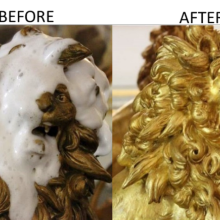The surfaces of historical artistic and cultural objects are often soiled as a result of long-term exposure to environmental influences. The process of cleaning these objects presents major challenges as each surface requires a tailor-made cleaning method to remove dirt without damaging the piece of art. A research team around Cosima Stubenrauch (University of Stuttgart, Germany & USIAS, France) and Wiebke Drenckhan (MIM team of the ICS), in collaboration with Dirk Blunk (University of Cologne, Germany) and Heinrich Piening (Bavarian Administration of State-Owned Palaces, Gardens and Lakes, Germany) has now been able to reveal the great potential of liquid foams for this task. Not only do foams reduce the amount of detergents by up to 90% and allow covering complex surface shapes, but they also generate additional physical cleaning mechanisms. Although it has been known for quite some time that foams are capable of carrying away the dirt from surfaces like sponges, the team has shown that this mechanism is far more efficient when the foam bubbles perform additional wiping actions on the surface – just like we do when cleaning a dirty table. This wiping is driven by the inherent instability of liquid foams in which bubbles pop and move around permanently. The researchers could show that this part of the cleaning process can be optimised when working with foams with the “right instability”: the foams need to be sufficiently stable to maintain the sponge-effect, while they need to be sufficiently unstable to ensure an optimal “bubble-wipe”. These combined effects are so efficient that it is sufficient to simply let the foam sit on the surface for a while before removing it by blowing. No additional mechanical action is needed! Having shown this fundamental principle on model surfaces, the team is now testing the approach on real historical objects which are difficult to clean with other methods. The team is also in touch with companies to explore this cleaning concept for other types of surfaces.
For further information please contact
Prof. Cosima Stubenrauch
Institute of Physical Chemistry
University of Stuttgart


